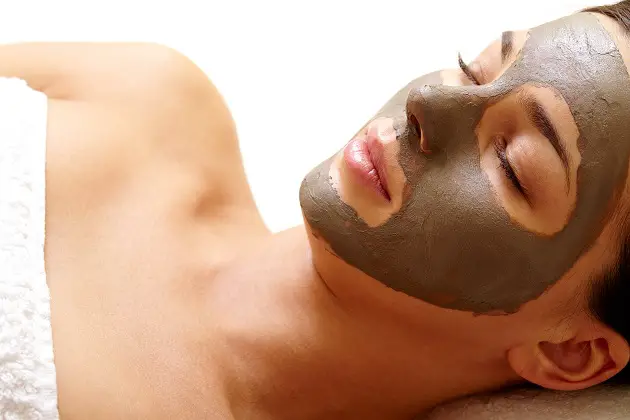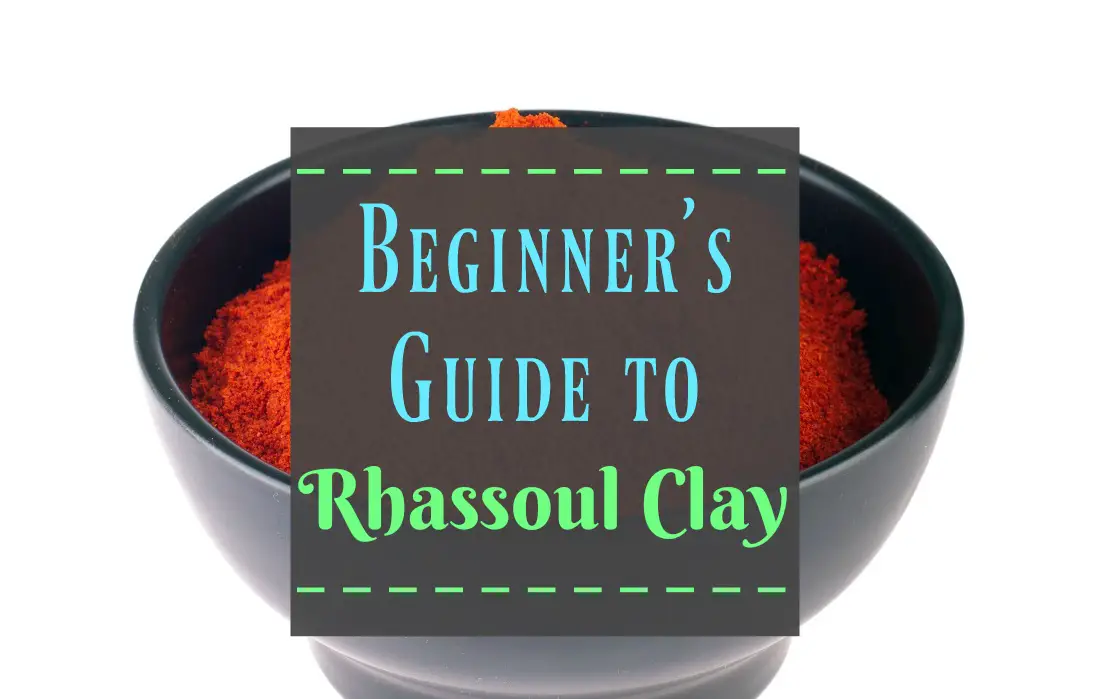The beauty industry is one of the largest growing in the United States.
However, in many cases, older, tried and true remedies are actually the most effective.
Rhassoul clay is building up a dedicated following thanks to its unique cleansing and toning properties.
What Is Rhassoul (Ghassoul) Clay?
It has been used for over a thousand years as a beauty aid in Morocco, Turkey, and throughout North Africa and the Middle East.
Women in these regions use this mineral-rich clay to care for their skin and hair. However, the Western world is only just catching up to the benefits of this natural clay.
This clay is mixed with water and then rubbed into the hair, face, and skin.
In some areas, this is done with a special glove called a kessa that assists in the cleansing and exfoliating process. Any exfoliating glove can be used for this purpose.
Rhassoul (or ghassoul) clay is also called red clay, Moroccan red clay, and a variety of other regional names.
The red color, as well as many of the beauty benefits, are due to the high mineral content of this clay.
It contains iron, magnesium, silica, sodium, potassium, and a wide variety of trace nutrients that can be beneficial to skin and hair health.

Benefits
There are several benefits to using this type of clay on the face and hair.
Lovers of this beauty product say that it softens skin and hair. Like many mud masks, it removes dead skin cells and smooths the skin. In addition, it tightens the pores.
Rhassoul clay also may have dramatic anti-aging effects.
According to analytic chemists who performed an analysis of its components, it can increase elasticity in the skin.(1) This is particularly true when it is mixed with honey rather than water to make a face mask.
Many people who use this kind of clay do so for its effect on oil and sebum production.
It can reduce blemishes, blackheads, oiliness, and other unwanted conditions of the skin. In addition, it makes hair look cleaner and can even help to prevent dandruff.
Some women use it in place of shampoo.
This kind of clay has a powerful negative charge, which means it can effectively cleanse skin and even pores.
The sebum and oils that clog pores and cause acne and blackheads tend to be positively charged. These are pulled out of pores by negatively charged substances such as this clay.
Rhassoul clay is relatively inexpensive.
It has to be mixed with water to be activated, but can be stored indefinitely until then. Its high mineral content is good for hair, nails, and most external uses.
This combined with its low cost makes it a choice of growing popularity in the Western world.
Use

Rhassoul clay is one of the more versatile beauty remedies on the market. It can be used almost anywhere on the human body with good results.
It is enjoyed for its silky-smooth texture and its many positive effects on skin and hair.
Rhassoul clay comes as a fine, smooth powder that must be rehydrated in order to be used.
It can be rehydrated with a variety of substances to enhance its effect.
To use it as a mask for the skin or body, simply mix the dry clay with water, honey, or other substances to make a silky paste.
To add a pleasant smell, consider using rosewater or other waters with a scent.
Smooth this mixture over the desired area and leave it until it dries. This mask will have to be rinsed off carefully.
To make a facial scrub, mix Rhassoul clay in even parts with oatmeal before hydrating. Use this scrub to gently exfoliate your face for two minutes before rinsing it completely.
This will remove dead skin as well as dirt and sebum that have built up in the pores.
Rhassoul clay can be useful for hair that needs oil-free moisture and shine, either as a hair mask or even as a shampoo.
Make a thin liquid, using about 1/4 Tbsp of the clay to every 1/4 cup water, and massage it into wet hair. Leave for 30 seconds and rinse immediately.
It is important not to let this mixture dry, as it can become hard and break hair.
Rhassoul clay has been found in several studies to adsorb a variety of different toxic substances. To make a safe, natural detox for feet, armpits, or other areas of the body, mix clay into hot water at a ratio of 1 tsp to every cup of fluid.
Soak the desired areas in this mixture before rinsing thoroughly.
Side Effects
Because it is all-natural, rhassoul clay has very few side effects.
The chances of an allergic reaction are rare, although this is possible in people who have an allergy to silica.
Because this substance is an effective cleaner, a skin may feel tighter immediately after a treatment.
This can be resolved by adding a noncomedogenic (non-pore-clogging) light moisturizer to your skincare routine immediately after the clay treatment.
If allowed to dry completely in hair, this and all kinds of clay can cause breakage. Clay dries to an extremely hard consistency that can break hair easily, so it is important to keep all clay preparations moist or wet when they are on your hair.
Rhassoul Clay vs. Bentonite Clay
In many ways, Rhassoul clay performs the same purifying and cleansing functions as Bentonite clay.
However, there are several key differences between the two.
First, Rhassoul is not intended for internal use. There may be exceptions but this clay should never be ingested without a doctor’s approval.
Some clays are used this way; however, Rhassoul is too high in minerals to be ingested on a regular basis by most people.
Another key difference is that Rhassoul clay does not contain lead while Bentonite clay may contain small amounts.
These small amounts can have health effects when the clay is used on a regular basis. In general, it is good to avoid products that may have lead in any significant quantity.
Last, Rhassoul clay contains a higher mineral content than Bentonite clay.
This is responsible for the notable color difference between the two products. These minerals can have many positive effects on skin and hair.
Both Rhassoul and Bentonite clays can have health benefits.
However, they are very different products. A physician, aesthetician, or other professionals can help you decide which is best for your unique health issues.
Scientific Studies
Because Rhassoul clay is a regional product that is new to the Western world, there are very few scientific studies on its use. A few universities and research organizations have begun to examine its purported benefits.
The University of Toulouse tested this kind of clay and found that it is highly negatively charged and thus effective in removing impurities and sebum from pores in the skin.(2)
Most blackheads, as well as toxins, are positively charged, so a negatively charged substance will draw them out.
This clay is rich in silica, which has a variety of anti-aging benefits.
Silica is a major component of healthy skin, hair, and fingernails. According to the review published in Anais Brasileiros de Dermatologia journal, it can stimulate collagen production, which gives skin increased elasticity and prevents the effects of aging such as wrinkles and drooping.(3)
Although this kind of clay has not been intensively studied, it has been used continuously for many hundreds of years with no ill effects.
It does not contain any substances known to be harmful, but is rich in ingredients that have documented health benefits. Using it topically in moderation is unlikely to cause unwanted side effects.
Where to Find Moroccan Rhassoul Clay?
This type of clay is available in some markets, but can be difficult to locate.
However, there are several online sources for customers who wish to try it.
Organic natural rhassoul clay is available on Amazon from Moroccan suppliers. This product is in a powdered form, so it can be rehydrated for regular use.
This particular product has very high ratings and positive reviews from customers who have bought it in the past.
Carol’s Daughter (check on Amazon), a popular skincare brand, sells a hair mask with this clay as the active ingredient. It is purported to increase shine in over-tired or over-processed hair.
Rhassoul clay can also be purchased in a hydrated paste form, ready to be used in skin and hair masks.
While this product will not last as long as dry powdered forms, many people prefer the convenience of a ready-made product.
These products all have high reviews that are consistent with the claims made about this product.
People who struggle with skin or hair care issues may find that these products are the answer to their problems.
In conclusion
Rhassoul clay is not a miracle substance, but it may for helpful for certain types of hair and skin issues.
People who are ready to give it a try can follow these steps:
- Purchase dry or hydrated clay from a reputable supplier.
- Rehydrate the clay (if purchased in a dry form) with honey, rosewater, or your choice of liquids until it is the desired consistency.
- Apply to skin, nails, and/or hair. If applying to hair, rinse thoroughly before it completely dries. If applying to skin or nails, it is fine to let it dry thoroughly.
- Rinse the affected area with warm, clean water and dry gently.
- Enjoy healthier, more youthful skin, hair, and nails.
References
1.Sana, El Fadeli & Pineau, Alain & N, Lekouch & Sedki, Azeddine. (2010). Analysis of traditional pharmacopeia product from Morocco ‘Rhassoul’. Analytical Chemistry: An Indian Journal. 2-3.
2.Bouna, Lahcen and Rhouta, Benaïssa and Amjoud, M’barek and Jada, Amane and Maury, Francis and Daoudi, Lahcen and Senocq, François Electrokinetic and ionic dyes adsorptionstudies of Moroccan stevensite Jbel Rhassoul clay. (2011) Journal of optoelectronics and advanced materials – Symposia, vol. 3 (n° 3). pp. 107-109. ISSN 2066-0596
3.Araújo, Lidiane Advincula de, Addor, Flavia, & Campos, Patrícia Maria Berardo Gonçalves Maia. (2016). Use of silicon for skin and hair care: an approach of chemical forms available and efficacy. Anais Brasileiros de Dermatologia, 91(3), 331-335. https://dx.doi.org/10.1590/abd1806-4841.20163986
Leave Feedback: Was this article helpful?


